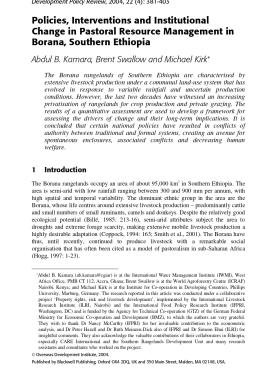Development Policy Review - 2004 - Kamara - Policies Interventions and Institutional Change in Pastoral Resource
Development Policy Review - 2004 - Kamara - Policies Interventions and Institutional Change in Pastoral Resource
The Borana rangelands occupy an area of about 95,000 km2 in Southern Ethiopia. The area is semi-arid with low rainfall ranging between 300 and 900 mm per annum, with high spatial and temporal variability. The dominant ethnic group in the area are the Borana, whose life centres around extensive livestock production – predominantly cattle and small numbers of small ruminants, camels and donkeys. Despite the relatively good ecological potential (Billé, 1985: 213-16), semi-arid attributes subject the area to droughts and extreme forage scarcity, making extensive mobile livestock production a highly desirable adaptation (Coppock, 1994: 163; Smith et al., 2001). The Borana have thus, until recently, continued to produce livestock with a remarkable social organisation that has often been cited as a model of pastoralism in sub-Saharan Africa (Hogg, 1997: 1-23).

